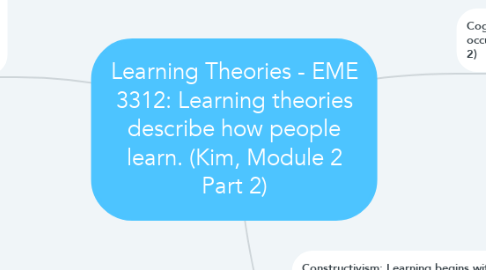Learning Theories - EME 3312: Learning theories describe how people learn. (Kim, Module 2 Part 2)
by Tony Tolson

1. Cognitivism: Learning is something that occurs in the brain (Kim, Module 2 Part 2)
1.1. Robert Gagne: Conditions of Learning
1.2. John Sweller: Cognitive Load Theory
1.3. David Merrill: Component Display Theory
1.4. Edgar Dale: Cone of Experience (Learning Pyramid)
1.5. Jean Piaget: Theory of Cognitive Development
2. Constructivism: Learning begins with the knowledge and experiences the learner brings to the event. Learners then apply that prior knowledge to make sense of a new situation. (Kim, Module 2 Part 2)
2.1. John Dewey: Functional Psychology
2.2. Jerome Bruner: Cognitive Psychology
2.3. Jean Lave: Situated Learning, Communities of Practice
2.4. Seymour Papert: Constructionism
2.5. George Siemens: Connectivism theory
3. Behaviorism: learning results in observable changes in behavior and that those changes in behavior are developed over a period of time as a result of consequences associated with correct or incorrect behaviors (Kim, Module 2 Part 2)
3.1. Ivan Pavlov: Classical Conditioning
3.2. John B. Watson: psychological school of behaviorism
3.3. Edward Thorndike: Operant Conditioning
3.4. B.F. Skinner: advanced Operant conditioning, behavioral philosophy
3.5. Clark Hull: Drive Theory (Human Motivation


